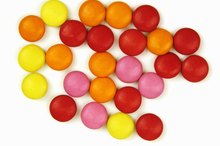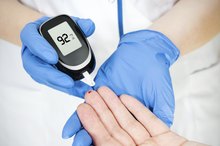Heart Racing & Dizziness After Eating
If you experience a racing heart and dizziness within one to three hours after eating, you may have a condition called reactive hypoglycemia. Reactive hypoglycemia, also referred to as postprandial hypoglycemia, is characterized by a drop in blood sugar, usually below 70 mg/dL. While most cases of hypoglycemia are associated with diabetes, reactive hypoglycemia usually occurs in individuals without diabetes.
Causes
The National Diabetes Information Clearinghouse notes that the exact cause of most cases of reactive hypoglycemia cannot be identified 1. One theory suggests that people prone to reactive hypoglycemia may not release the hormone glucagon, which serves as a backup source of energy, correctly. Another theory is that people who experience reactive hypoglycemia are overly sensitive to epinephrine, which causes the symptoms associated with hypoglycemia.
Stomach surgery can also increase the chance of experiencing reactive hypoglycemia. In some individuals who have had prior stomach surgery, food passes more quickly through the stomach and into the small intestine. As a result, blood sugar drops.
- The National Diabetes Information Clearinghouse notes that the exact cause of most cases of reactive hypoglycemia cannot be identified 1.
- Another theory is that people who experience reactive hypoglycemia are overly sensitive to epinephrine, which causes the symptoms associated with hypoglycemia.
Other Symptoms
Is Glucose Stored in the Human Body?
Learn More
The symptoms of reactive hypoglycemia occur as a result of a lack of glucose in your brain. Some people also experience blurred vision and muscle tremors.
Treatment and Prevention
Most people with reactive hypoglycemia do not require medical treatment and can control blood sugar levels by making some changes in eating habits. Eating a series of small meals or snacks throughout the course of the day, instead of three or fewer large meals, can provide your body with a steady supply of glucose and help keep your blood sugar levels steady. Aim to eat five or six times per day. It is also important to pay attention to what you eat. Each meal or snack should contain a balance of carbohydrates, lean protein and a small amount of fat.
- Most people with reactive hypoglycemia do not require medical treatment and can control blood sugar levels by making some changes in eating habits.
- Eating a series of small meals or snacks throughout the course of the day, instead of three or fewer large meals, can provide your body with a steady supply of glucose and help keep your blood sugar levels steady.
Considerations
Why Do I Get Shaky When I Eat Sugar?
Learn More
MayoClinic.com notes that it is important to engage in regular physical activity. The best time to exercise is directly after a meal or after a snack that contains carbohydrates. This ensures that your body has enough glucose to provide energy to sustain your physical activity.
It is also important to drink plenty of fluids, especially when increasing your fiber intake. Aim to drink at least eight glasses of water per day. Limit caffeinated beverages, such as coffee, tea and soda, to no more than two per day. Avoid alcohol, which directly lowers your blood sugar.
- MayoClinic.com notes that it is important to engage in regular physical activity.
- The best time to exercise is directly after a meal or after a snack that contains carbohydrates.
Related Articles
References
- MayoClinic.com; Reactive Hypoglycemia; October 2010
- Service FJ, Vella A. Hypoglycemia in adults without diabetes mellitus: Diagnostic approach. UpToDate. Updated September 19, 2018.
- Service FJ, Vella A. Postprandial (reactive) hypoglycemia. UpToDate. Updated June 11, 2018
- National Institute of Diabetes and Digestive and Kidney Diseases. Low blood sugar (hypoglycemia). Updated August, 2016.
- Stuart K, Field A, Raju J, Ramachandran S. Postprandial reactive hypoglycaemia: Varying presentation patterns on extended glucose tolerance tests and possible therapeutic approaches. Case Rep Med. 2013;2013:273957. doi:10.1155/2013/273957
- Martens P, Tits J. Approach to the patient with spontaneous hypoglycemia. Eur J Intern Med. 2014 Jun;25(5):415-21. doi: 10.1016/j.ejim.2014.02.011
- Galati SJ, Rayfield EJ. Approach to the patient with postprandial hypoglycemia. Endocr Pract. 2014 Apr;20(4):331-40. doi:10.4158/EP13132.RA
- Salehi M, Vella A, McLaughlin T, Patti ME. Hypoglycemia after gastric bypass surgery: Current concepts and controversies. J Clin Endocrinol Metab. 2018;103(8):2815–2826. doi:10.1210/jc.2018-00528
- Douillard C, Mention K, Dobbelaere D, Wemeau JL, Saudubray JM, Vantyghem MC. Hypoglycaemia related to inherited metabolic diseases in adults. Orphanet J Rare Dis. 2012;7:26. Published 2012 May 15. doi:10.1186/1750-1172-7-26
- Brutsaert EF. Hypoglycemia. Merck Manual Professional Version. Updated January, 2019.
- American Diabetes Association. Hypoglycemia (low blood sugar).
- Haider A, Burks JK, Cheema H, et al. Postprandial hypoglycemia: Complication of peptic ulcer surgery. Am J Med. 2017 Dec;130(12):e527-e529. doi:10.1016/j.amjmed.2017.06.010
- Service FJ, Vella A. Hypoglycemia in adults without diabetes mellitus: Diagnostic approach. Updated September 19, 2018.
- Service FJ, Vella A. Postprandial (reactive) hypoglycemia. Updated June 11, 2018
Writer Bio
Lindsay Boyers has a Bachelor of Science in nutrition from Framingham State College and a certificate in holistic nutrition from the American College of Healthcare Sciences. She is also a licensed aesthetician with advanced training in skincare and makeup. She plans to continue on with her education, complete a master's degree program in nutrition and, ultimately, become a registered dietitian.








